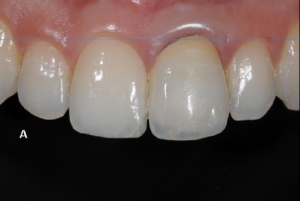 This retrospective study aimed to analyse the fate of the buccal crest after immediate implant placement (IIP) through the use of cone beam computed tomography (CBCT). In 16 consecutive patients, an implant was placed in a more palatal position after extraction, thereby creating a gap of at least 2 mm between the implant and the buccal crest. Subsequently, this gap was filled with a bone substitute. Preoperatively, immediate postoperatively, and late postoperatively, a CBCT was made to measure the thickness of the buccal crest. After application of the bone substitute, the buccal crest increased in thickness from 0.9 mm to 2.4 mm (mean). At a mean of 103 weeks after IIP, late postoperative CBCT scans showed that the thickness of the buccal crest was compacted to 1.8 mm. In the same period, the height of the buccal crest increased by 1.6 mm (mean) to, on average, 1.2 mm above the implant shoulder. The aesthetic outcome was analysed using the White and Pink Esthetic Score (WES and PES). Both scored high: 8.4 and 11.8, respectively. Within the limitations of this study, the results of this IIP protocol are promising. Long-term prospective research on this topic on a large number of patients is necessary.
This retrospective study aimed to analyse the fate of the buccal crest after immediate implant placement (IIP) through the use of cone beam computed tomography (CBCT). In 16 consecutive patients, an implant was placed in a more palatal position after extraction, thereby creating a gap of at least 2 mm between the implant and the buccal crest. Subsequently, this gap was filled with a bone substitute. Preoperatively, immediate postoperatively, and late postoperatively, a CBCT was made to measure the thickness of the buccal crest. After application of the bone substitute, the buccal crest increased in thickness from 0.9 mm to 2.4 mm (mean). At a mean of 103 weeks after IIP, late postoperative CBCT scans showed that the thickness of the buccal crest was compacted to 1.8 mm. In the same period, the height of the buccal crest increased by 1.6 mm (mean) to, on average, 1.2 mm above the implant shoulder. The aesthetic outcome was analysed using the White and Pink Esthetic Score (WES and PES). Both scored high: 8.4 and 11.8, respectively. Within the limitations of this study, the results of this IIP protocol are promising. Long-term prospective research on this topic on a large number of patients is necessary.
Lees hier de hele case study.
Met dank aan E. Groenendijk, T. A. Staas, F. E. J. Graauwmans, E. Bronkhorst, L. Verhamme, T. Maal, G. J. Meijer.


